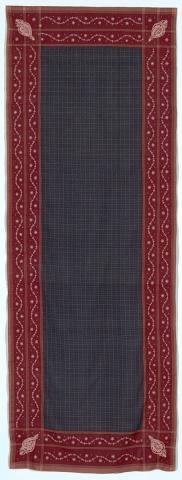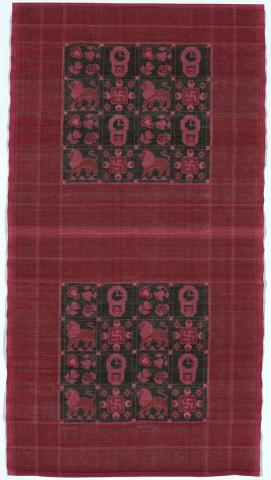Telia rumal textiles from South India
By Dana McCown
March 2024
The Gallery’s collection of extraordinary telia rumal was made using time-consuming double ikat dyeing techniques. Few weavers remain in South India with the skills required to create these attractive textiles — however, in the village of Puttapaka, Nalgonda District, the Gajam family have been keeping the tradition alive.

Gajam Govardhan’s award-winning 100 motif telia rumal 2011, installed for the first rotation of ‘I Can Spin Skies’, QAG, November 2023 / Gift of Dana McCown through the Queensland Art Gallery | Gallery of Modern Art Foundation 2020 / © QAGOMA / Photograph: J Ruckli, QAGOMA
The name telia rumal is derived from the oil process that enables the cotton fibre to accept dye. Telia means oil and rumal means square, referring to the basic shape of the textile. Traditionally the imagery woven into these textiles was simple and geometric, but over time both Arabic and Hindu imagery was introduced. In the 1920s, more modern images emerged, from airplanes to clocks.
The more common single form of ikat is a process where the warp or weft yarn is resist-tied before being dyed and then woven. (‘Resist dying’ uses various methods — in this case, tied-off sections of yarn — to dye textiles with patterns.) Single ikat is found in many places around the world, but double ikat is rare, requiring a high degree of work and precision found in only a few places, particularly in Japan, India and Bali.

Examples of weft, warp and double ikat styles (l–r), as illustrated by the author / Courtesy: Dana McCown
Traditionally, telia rumal has been worn in various ways by both men and women. This contemporary telia rumal shawl/dupatta (pictured below, left), hand-embroidered with silk thread in a paisley motif with trailing flowers, was commissioned by late textile enthusiast, Mrs Suraiya Hasan of Hyderabad. She searched for weavers and embroiderers able to replicate old styles seen in museum photographs.
Today, telia rumals are recognised for their craftsmanship and beauty, and are also created for decorative purposes. Master Weaver Gajam Govardhan’s 100 motif telia rumal 2011 contains 100 different images of significance. Because there are no repeated images, the work required to resist-tie the yarn took months. Hundreds of bundles were individually tied and died for warp and weft. It is considered his ‘masterpiece’. For this extraordinary accomplishment, he was awarded the Padma Shri Award — the fourth-highest civilian award for distinguished service in India.
This text is an except of an essay on the QAGOMA Blog by Dana McCown: ‘Telia Rumal: Double ikat textiles from South India’. Dana McCown is a textile specialist world-renowned for her research on the telia rumal tradition. Her expertise is captured in a remarkable collection of textiles, gifted to the Gallery in 2020, which she worked closely with artists to develop over the course of more than 25 years.
Digital story context and navigation
Related resources


